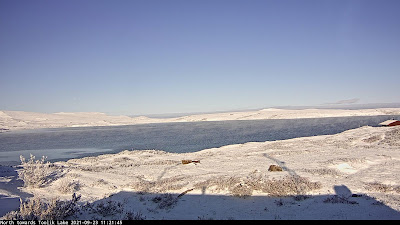King Salmon with a low temp Wed morning of 14F (-10.0C) sets a daily record for the fifth consecutive day. On Sunday the low of 13F (-10.6C) set a new September monthly record low temp. Previous record 15F (-9.4C) in 1983 and 2003. #akwx @Climatologist49 @kdlgradio @climateguyw
— Rick Thoman (@AlaskaWx) September 29, 2021
Objective Comments and Analysis - All Science, No Politics
Primary Author Richard James
2010-2013 Author Rick Thoman
Thursday, September 30, 2021
Cold Deepens
Thursday, September 23, 2021
First Zero
I may start posting these NWS-Fairbanks information statements regularly, as they often provide nice summary tidbits, and those not on Twitter may not always see them. (Note that the temperature later dropped to -4°F, -20°C, at Toolik this morning.)
--------------------------
Public Information Statement
National Weather Service Fairbanks AK
1207 AM AKDT Thu Sep 23 2021
...Fall Arrives In Northern Alaska With Below Zero Temperature...
The first day of fall, on Wednesday, was greeted by a temperature of 1 degree below zero at the Toolik Lake Field Station, on the North Slope of Alaska, just north of the Brooks Range. Toolik Lake was also reporting over 3 inches of snow.
--------------------------
The current webcam view shows some steam fog over the lake, and what looks like a patch of newly formed ice. What a beautiful scene!
Wednesday, September 22, 2021
Snow Totals
Eastern interior locations from the Tanana to Yukon valleys were the big winners in the early snowfall of the last couple of days, with as much as 9" reported in Tok.
According to the NWS, this morning's reported snow depth of 7" in Eagle is the highest on record for this early in the season, although Rick Thoman notes that the depth seems a bit too high for a 2-day accumulation of 7.5"; one would expect more compaction than that.
Here's a map of reported snow depths today across the southeastern quadrant of the interior.
Returning to the cold in Bettles, the high temperature on Monday was only 32°F, which is quite notable for so early in the season, although the rate of seasonal cooling is extremely rapid. 1992 and 1996 saw freezing days about a week earlier (September 14), and 2013 was also notable for early cold (32°F high on the 21st). Typically it takes until about the first week of October to see a sub-freezing day in Bettles.
Monday, September 20, 2021
First Snow
Pretty September afternoon at @Toolik at ~2500' (760m) on the north side of the Brooks Range, where the morning lows was +4F (-15.0C). Not a record though, #OTD in 1989 & 1992 the low temps were below 0F. #akwx @Climatologist49 @uafairbanks pic.twitter.com/u19oTe7tO1
— Rick Thoman (@AlaskaWx) September 20, 2021
Saturday, September 18, 2021
Simulated Rainfall Extremes
| 2-day | GEFS | Observed |
| Fairbanks | 3.4" | 4.3" |
| Utqiaġvik | 1.7" | 1.4" |
| Nome | 4.2" | 3.0" |
| Yakutat | 12.5" | 13.7" |
| 7-day | GEFS | Observed |
| Fairbanks | 5.1" | 6.1" |
| Utqiaġvik | 2.3" | 1.9" |
| Nome | 6.3" | 5.3" |
| Yakutat | 18.5" | 20.6" |
Sunday, September 12, 2021
August and Summer Climate Anomalies
Time continues to elude me for more frequent posts, but here's a look back at statewide climate anomalies during August and for the summer as a whole.
First, the NCEI climate division data indicate that August was the coolest summer month - and the coolest relative to normal - since August 2015. The statewide average temperature of 49.4°F was about 1°F below the 1991-2020 normal, but would have been slightly above normal prior to the 1980s. Precipitation was significantly above normal statewide, but unlike June and July the wet anomaly was across the interior and southeast, not along the west coast.
































